Jiapeng Wang
School of Information and Communication Engineering, Xidian University, Xi'an, China
WSM: Decay-Free Learning Rate Schedule via Checkpoint Merging for LLM Pre-training
Jul 23, 2025Abstract:Recent advances in learning rate (LR) scheduling have demonstrated the effectiveness of decay-free approaches that eliminate the traditional decay phase while maintaining competitive performance. Model merging techniques have emerged as particularly promising solutions in this domain. We present Warmup-Stable and Merge (WSM), a general framework that establishes a formal connection between learning rate decay and model merging. WSM provides a unified theoretical foundation for emulating various decay strategies-including cosine decay, linear decay and inverse square root decay-as principled model averaging schemes, while remaining fully compatible with diverse optimization methods. Through extensive experiments, we identify merge duration-the training window for checkpoint aggregation-as the most critical factor influencing model performance, surpassing the importance of both checkpoint interval and merge quantity. Our framework consistently outperforms the widely-adopted Warmup-Stable-Decay (WSD) approach across multiple benchmarks, achieving significant improvements of +3.5% on MATH, +2.9% on HumanEval, and +5.5% on MMLU-Pro. The performance advantages extend to supervised fine-tuning scenarios, highlighting WSM's potential for long-term model refinement.
RV-Syn: Rational and Verifiable Mathematical Reasoning Data Synthesis based on Structured Function Library
Apr 29, 2025Abstract:The advancement of reasoning capabilities in Large Language Models (LLMs) requires substantial amounts of high-quality reasoning data, particularly in mathematics. Existing data synthesis methods, such as data augmentation from annotated training sets or direct question generation based on relevant knowledge points and documents, have expanded datasets but face challenges in mastering the inner logic of the problem during generation and ensuring the verifiability of the solutions. To address these issues, we propose RV-Syn, a novel Rational and Verifiable mathematical Synthesis approach. RV-Syn constructs a structured mathematical operation function library based on initial seed problems and generates computational graphs as solutions by combining Python-formatted functions from this library. These graphs are then back-translated into complex problems. Based on the constructed computation graph, we achieve solution-guided logic-aware problem generation. Furthermore, the executability of the computational graph ensures the verifiability of the solving process. Experimental results show that RV-Syn surpasses existing synthesis methods, including those involving human-generated problems, achieving greater efficient data scaling. This approach provides a scalable framework for generating high-quality reasoning datasets.
HeteRAG: A Heterogeneous Retrieval-augmented Generation Framework with Decoupled Knowledge Representations
Apr 12, 2025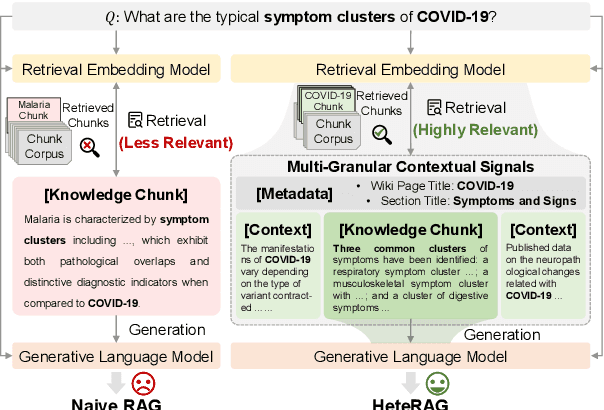



Abstract:Retrieval-augmented generation (RAG) methods can enhance the performance of LLMs by incorporating retrieved knowledge chunks into the generation process. In general, the retrieval and generation steps usually have different requirements for these knowledge chunks. The retrieval step benefits from comprehensive information to improve retrieval accuracy, whereas excessively long chunks may introduce redundant contextual information, thereby diminishing both the effectiveness and efficiency of the generation process. However, existing RAG methods typically employ identical representations of knowledge chunks for both retrieval and generation, resulting in suboptimal performance. In this paper, we propose a heterogeneous RAG framework (\myname) that decouples the representations of knowledge chunks for retrieval and generation, thereby enhancing the LLMs in both effectiveness and efficiency. Specifically, we utilize short chunks to represent knowledge to adapt the generation step and utilize the corresponding chunk with its contextual information from multi-granular views to enhance retrieval accuracy. We further introduce an adaptive prompt tuning method for the retrieval model to adapt the heterogeneous retrieval augmented generation process. Extensive experiments demonstrate that \myname achieves significant improvements compared to baselines.
YuLan-Mini: An Open Data-efficient Language Model
Dec 24, 2024



Abstract:Effective pre-training of large language models (LLMs) has been challenging due to the immense resource demands and the complexity of the technical processes involved. This paper presents a detailed technical report on YuLan-Mini, a highly capable base model with 2.42B parameters that achieves top-tier performance among models of similar parameter scale. Our pre-training approach focuses on enhancing training efficacy through three key technical contributions: an elaborate data pipeline combines data cleaning with data schedule strategies, a robust optimization method to mitigate training instability, and an effective annealing approach that incorporates targeted data selection and long context training. Remarkably, YuLan-Mini, trained on 1.08T tokens, achieves performance comparable to industry-leading models that require significantly more data. To facilitate reproduction, we release the full details of the data composition for each training phase. Project details can be accessed at the following link: https://github.com/RUC-GSAI/YuLan-Mini.
Imitate, Explore, and Self-Improve: A Reproduction Report on Slow-thinking Reasoning Systems
Dec 12, 2024


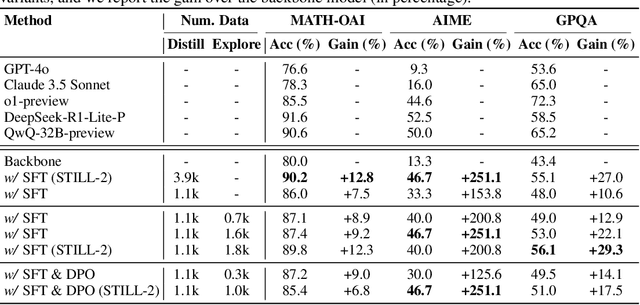
Abstract:Recently, slow-thinking reasoning systems, such as o1, have demonstrated remarkable capabilities in solving complex reasoning tasks. These systems typically engage in an extended thinking process before responding to a query, allowing them to generate more thorough, accurate, and well-reasoned solutions. These systems are primarily developed and maintained by industry, with their core techniques not publicly disclosed. In response, an increasing number of studies from the research community aim to explore the technical foundations underlying these powerful reasoning systems. Building on these prior efforts, this paper presents a reproduction report on implementing o1-like reasoning systems. We introduce an "imitate, explore, and self-improve" framework as our primary technical approach to train the reasoning model. In the initial phase, we use distilled long-form thought data to fine-tune the reasoning model, enabling it to invoke a slow-thinking mode. The model is then encouraged to explore challenging problems by generating multiple rollouts, which can result in increasingly more high-quality trajectories that lead to correct answers. Furthermore, the model undergoes self-improvement by iteratively refining its training dataset. To verify the effectiveness of this approach, we conduct extensive experiments on three challenging benchmarks. The experimental results demonstrate that our approach achieves competitive performance compared to industry-level reasoning systems on these benchmarks.
Technical Report: Enhancing LLM Reasoning with Reward-guided Tree Search
Nov 18, 2024



Abstract:Recently, test-time scaling has garnered significant attention from the research community, largely due to the substantial advancements of the o1 model released by OpenAI. By allocating more computational resources during the inference phase, large language models~(LLMs) can extensively explore the solution space by generating more thought tokens or diverse solutions, thereby producing more accurate responses. However, developing an o1-like reasoning approach is challenging, and researchers have been making various attempts to advance this open area of research. In this paper, we present a preliminary exploration into enhancing the reasoning abilities of LLMs through reward-guided tree search algorithms. This framework is implemented by integrating the policy model, reward model, and search algorithm. It is primarily constructed around a tree search algorithm, where the policy model navigates a dynamically expanding tree guided by a specially trained reward model. We thoroughly explore various design considerations necessary for implementing this framework and provide a detailed report of the technical aspects. To assess the effectiveness of our approach, we focus on mathematical reasoning tasks and conduct extensive evaluations on four challenging datasets, significantly enhancing the reasoning abilities of LLMs.
VideoCLIP-XL: Advancing Long Description Understanding for Video CLIP Models
Oct 01, 2024Abstract:Contrastive Language-Image Pre-training (CLIP) has been widely studied and applied in numerous applications. However, the emphasis on brief summary texts during pre-training prevents CLIP from understanding long descriptions. This issue is particularly acute regarding videos given that videos often contain abundant detailed contents. In this paper, we propose the VideoCLIP-XL (eXtra Length) model, which aims to unleash the long-description understanding capability of video CLIP models. Firstly, we establish an automatic data collection system and gather a large-scale VILD pre-training dataset with VIdeo and Long-Description pairs. Then, we propose Text-similarity-guided Primary Component Matching (TPCM) to better learn the distribution of feature space while expanding the long description capability. We also introduce two new tasks namely Detail-aware Description Ranking (DDR) and Hallucination-aware Description Ranking (HDR) for further understanding improvement. Finally, we construct a Long Video Description Ranking (LVDR) benchmark for evaluating the long-description capability more comprehensively. Extensive experimental results on widely-used text-video retrieval benchmarks with both short and long descriptions and our LVDR benchmark can fully demonstrate the effectiveness of our method.
DocLayLLM: An Efficient and Effective Multi-modal Extension of Large Language Models for Text-rich Document Understanding
Aug 27, 2024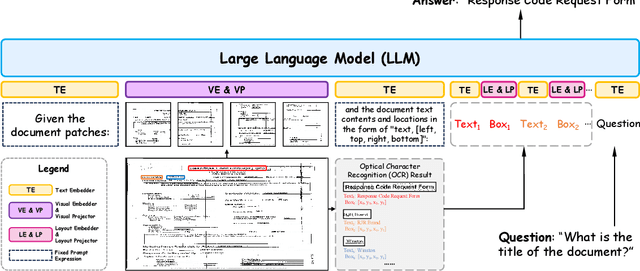
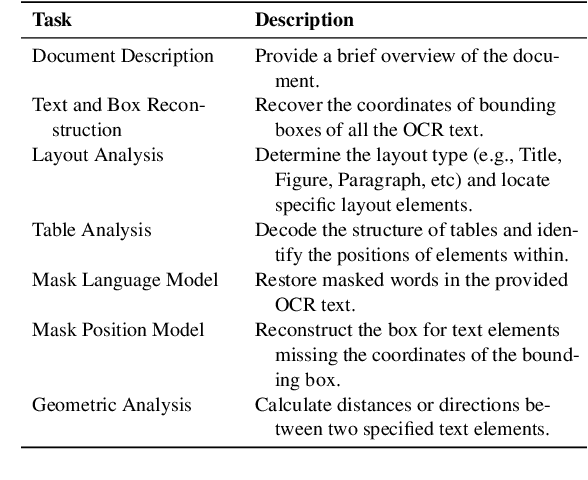


Abstract:Text-rich document understanding (TDU) refers to analyzing and comprehending documents containing substantial textual content. With the rapid evolution of large language models (LLMs), they have been widely leveraged for TDU due to their remarkable versatility and generalization. In this paper, we introduce DocLayLLM, an efficient and effective multi-modal extension of LLMs specifically designed for TDU. By integrating visual patch tokens and 2D positional tokens into LLMs and encoding the document content using the LLMs themselves, we fully take advantage of the document comprehension capability of LLMs and enhance their perception of OCR information. We have also deeply considered the role of the chain-of-thought (CoT) and innovatively proposed the techniques of CoT Pre-training and CoT Annealing. Our DocLayLLM can achieve remarkable performances with lightweight training settings, showcasing its efficiency and effectiveness. Experimental results demonstrate that our DocLayLLM surpasses existing OCR-dependent methods and also outperforms OCR-free competitors.
Towards Effective and Efficient Continual Pre-training of Large Language Models
Jul 26, 2024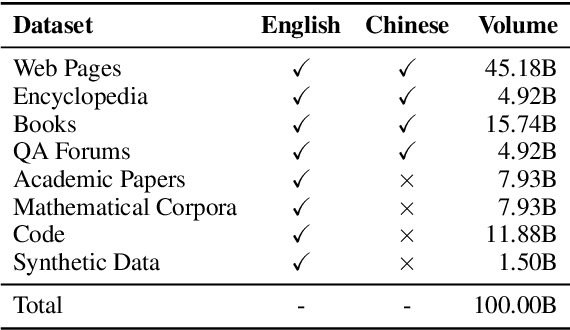
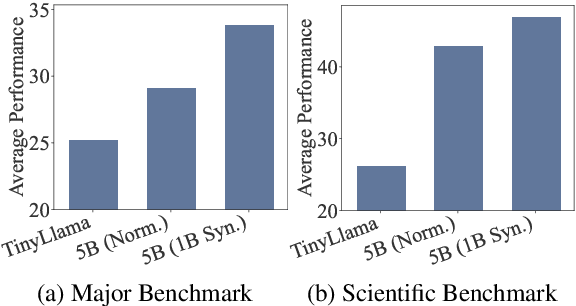
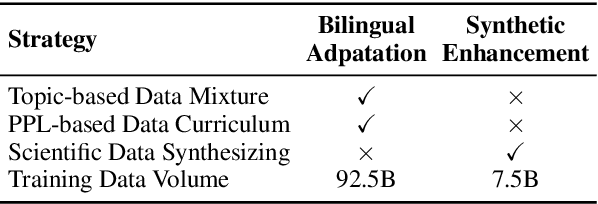
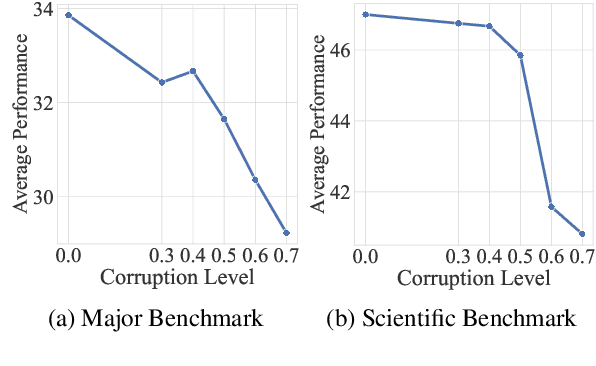
Abstract:Continual pre-training (CPT) has been an important approach for adapting language models to specific domains or tasks. To make the CPT approach more traceable, this paper presents a technical report for continually pre-training Llama-3 (8B), which significantly enhances the Chinese language ability and scientific reasoning ability of the backbone model. To enhance the new abilities while retaining the original abilities, we design specific data mixture and curriculum strategies by utilizing existing datasets and synthesizing high-quality datasets. Specifically, we synthesize multidisciplinary scientific question and answer (QA) pairs based on related web pages, and subsequently incorporate these synthetic data to improve the scientific reasoning ability of Llama-3. We refer to the model after CPT as Llama-3-SynE (Synthetic data Enhanced Llama-3). We also present the tuning experiments with a relatively small model -- TinyLlama, and employ the derived findings to train the backbone model. Extensive experiments on a number of evaluation benchmarks show that our approach can largely improve the performance of the backbone models, including both the general abilities (+8.81 on C-Eval and +6.31 on CMMLU) and the scientific reasoning abilities (+12.00 on MATH and +4.13 on SciEval), without hurting the original capacities. Our model, data, and codes are available at https://github.com/RUC-GSAI/Llama-3-SynE.
LLMBox: A Comprehensive Library for Large Language Models
Jul 08, 2024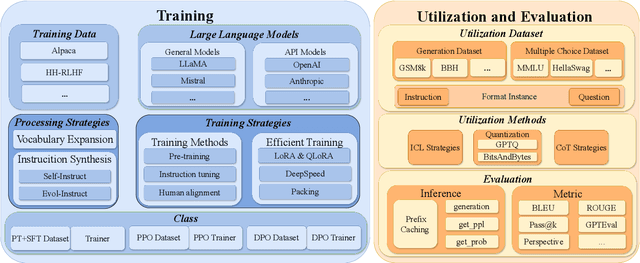
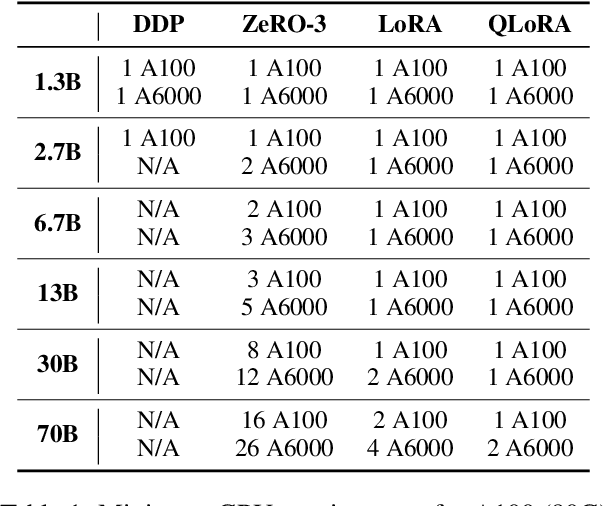
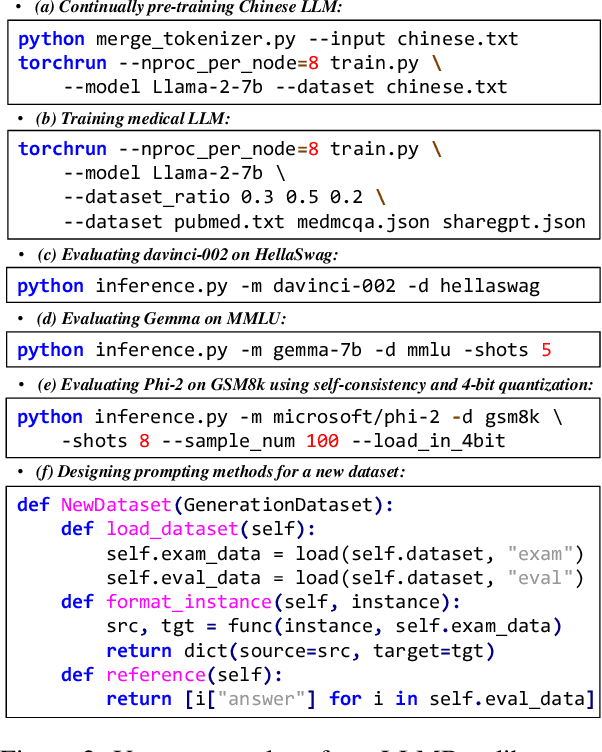

Abstract:To facilitate the research on large language models (LLMs), this paper presents a comprehensive and unified library, LLMBox, to ease the development, use, and evaluation of LLMs. This library is featured with three main merits: (1) a unified data interface that supports the flexible implementation of various training strategies, (2) a comprehensive evaluation that covers extensive tasks, datasets, and models, and (3) more practical consideration, especially on user-friendliness and efficiency. With our library, users can easily reproduce existing methods, train new models, and conduct comprehensive performance comparisons. To rigorously test LLMBox, we conduct extensive experiments in a diverse coverage of evaluation settings, and experimental results demonstrate the effectiveness and efficiency of our library in supporting various implementations related to LLMs. The detailed introduction and usage guidance can be found at https://github.com/RUCAIBox/LLMBox.
 Add to Chrome
Add to Chrome Add to Firefox
Add to Firefox Add to Edge
Add to Edge